Click on images to enlarge
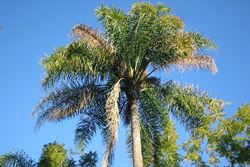
habit (Photo: Sheldon Navie)
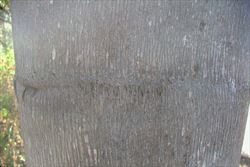
close-up of bark and leaf scar on main trunk (Photo: Sheldon Navie)
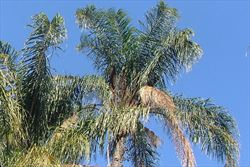
the massive feathery leaves (Photo: Sheldon Navie)
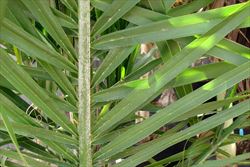
close-up of the very large elongated leaflets (Photo: Forest and Kim Starr, USGS)
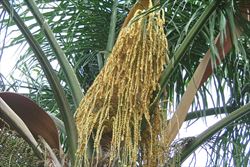
very large branched flower cluster (Photo: Sheldon Navie)

flowers and flower buds (Photo: Sheldon Navie)
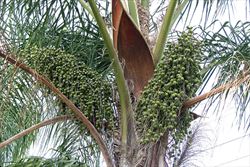
clusters of immature fruit, leaf stalks and large woody boat-shaped bract (Photo: Sheldon Navie)
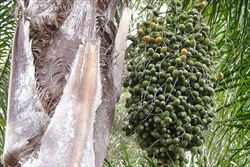
leaf sheaths and cluster of immature fruit (Photo: Sheldon Navie)
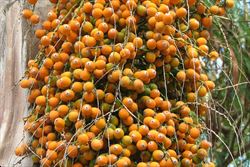
large cluster of mature fruit (Photo: Sheldon Navie)
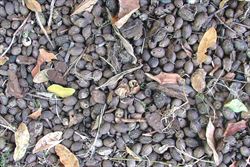
masses of old fruit under a large tree (Photo: Sheldon Navie)
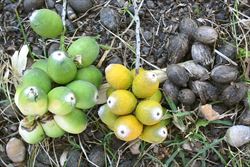
close-up of immature, almost mature and old fruit (Photo: Sheldon Navie)
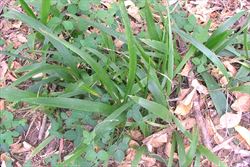
seedlings (Photo: Sheldon Navie)
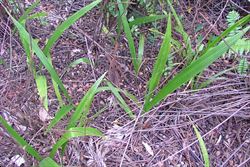
older seedlings (Photo: Sheldon Navie)
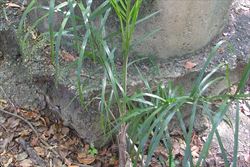
young plant (Photo: Sheldon Navie)
Scientific Name
Syagrus romanzoffiana (Cham.) Glassman
Synonyms
Arecastrum romanzoffianum (Cham.) Becc.Arecastrum romanzoffianum (Cham.) Becc.var. australe (Mart.) Becc.Arecastrum romanzoffianum (Cham.) Becc. var. genuinum (Cham.) Becc.Cocos australis Mart.Cocos datil Griseb. & DrudeCocos plumosa W. Hook.Cocos romanzoffiana Cham.Cocos romanzoffiana Cham. var. plumosa hort. ex Berger
Family
Arecaceae (Queensland, New South Wales, the ACT, Victoria, Tasmania, Western Australia and the Northern Territory)Palmae (South Australia)
Common Names
butia palm, cocos palm, feathery coconut, giriba palm, queen palm
Origin
Native to South America (i.e. eastern Brazil, Argentina, Paraguay and Uruguay).
Cultivation
Cocos palm (Syagrus romanzoffiana) is widely grown as a garden and street tree in the warmer parts of Australia.
Naturalised Distribution
This species is become widely naturalised in the eastern parts of Australia, particularly in sub-tropical regions. It is most widespread and common in south-eastern Queensland and is possibly also naturalised in the coastal districts of northern New South Wales. It has also recently been recorded as naturalised in tropical northern Queensland.
Also naturalised overseas in south-eastern USA (i.e. Florida).
Habitat
A weed of roadsides, disturbed sites, waste areas, watercourses (i.e. riparian areas) and urban bushland in sub-tropical and tropical regions.
Habit
A large palm tree with a single trunk growing up to 20 m tall.
Distinguishing Features
- a large palm tree with a single smooth grey trunk growing up to 20 m tall.
- its massive leaves can reach up to 5 m in length on mature trees.
- these leaves consist of a thick main stalk and numerous (300-500) very long leaflets (up to 1 m long and 3 cm wide).
- its large branched flower clusters (up to 2 m long) contain numerous small yellowish or cream-coloured flowers.
- the stalkless flowers are borne in groups of three, one flower in each group being female and the other two being male.
- its egg-shaped fruit (2.5-3 cm long) from green to yellow and then orange when fully mature.
Stems and Leaves
The trunk is smooth and grey, usually about 30 cm wide, with widely spaced rings (i.e. horizontal leaf scars).
The massive leaves can reach up to 5 m in length on mature trees. These leaves consist of a thick main stalk, with a large stem-clasping base (i.e. sheath), and numerous (300-500) very elongated leaflets. Each of the green strap-like leaflets is up to 1 m long and to 3 cm wide. These hairless (i.e. glabrous) leaflets have entire margins and pointed tips (i.e. acute apices). They are borne in different planes, giving the leaves a three-dimensional, feathery (i.e. plume-like) appearance.
Flowers and Fruit
The large flower clusters are initially enclosed in two bracts, one of which is very large and becomes woody and boat-shaped with age. These branched flower clusters (i.e. panicles) are up to 2 m long and contain numerous small yellowish or cream-coloured flowers. Separate male and female flowers are present in these clusters. The stalkless (i.e. sessile) flowers are borne in groups of three, with one of these being female and the other two being male. The male (i.e. staminate) flowers have three leathery sepals, three leathery petals and six stamens. The female (i.e. pistillate) flowers have three leathery sepals, three leathery petals and an ovary topped with a style and three stigmas. Flowering occurs mostly during spring.
The fruit (2.5-3 cm long and 1-2 cm wide) are crowded into very large hanging clusters. These fruit are egg-shaped (i.e. ovoid) and turn from green to yellow and then orange when fully mature. The have a hard woody centre and fleshy outer parts (i.e. they are drupes).
Reproduction and Dispersal
This species reproduces entirely by seed. These seeds are spread by bats and other animals that eat the fruit. They are also dispersed by water and in dumped garden waste.
Environmental Impact
Cocos palm (Syagrus romanzoffiana) is regarded as and environmental weed in Queensland and as a "sleeper weed" or potential environmental weed in New South Wales.
Legislation
Not declared or considered noxious by any state government authorities.
Management
For information on the management of this species see the following resources:
- the Biosecurity Queensland Fact Sheet on this species, which is available online at http://www.dpi.qld.gov.au.

